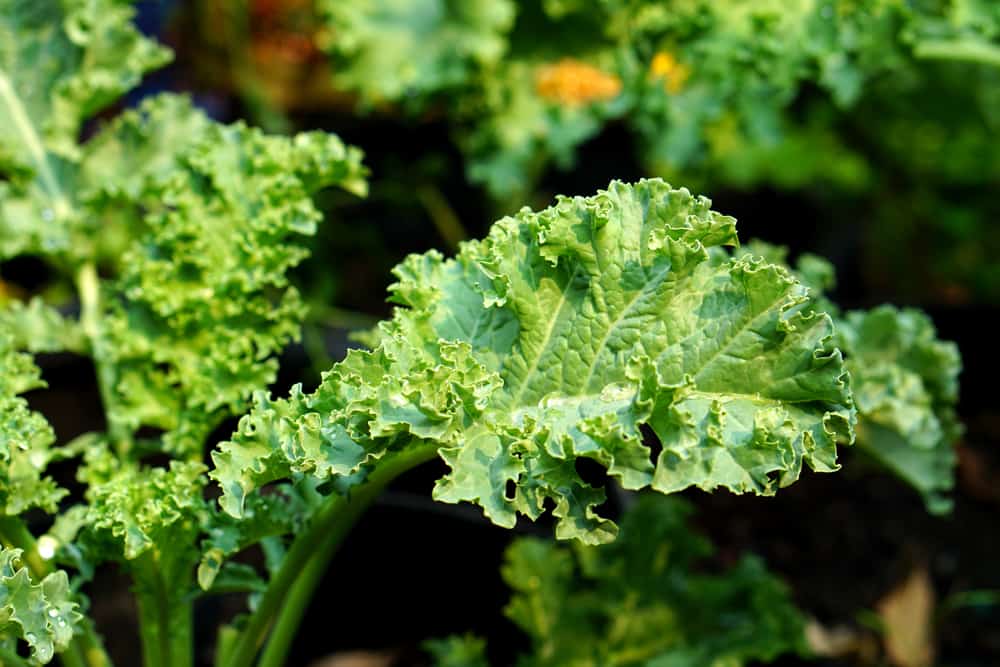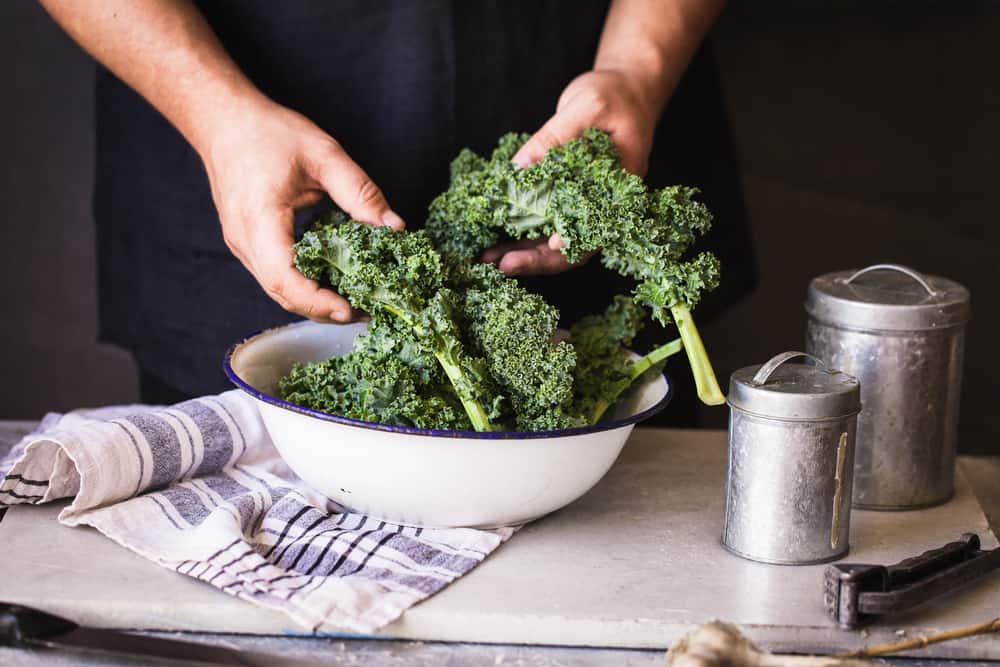With more and more people trying to live a healthier lifestyle, kale is becoming a favorite of many. It’s jampacked with nutrients, minerals, vitamins, and all that good stuff that helps our bodies stay in perfect shape. If you’re looking to buy the leafy green in bulky, you may want to know a thing or two about its shelf life, so let’s give you the lowdown on that. Ready?
Table of Contents
Does Kale Go Bad?
Yes, as with all fresh vegetables, kale does go bad. Essentially, how fresh the produce is when you buy it will play a huge role in determining how long it will last. Freshly-packed kale, for instance, will have a slightly longer shelf life than a bunch packed one or two days before the date of purchase if the right storage practices are followed.
One important thing to keep in mind when buying the leafy vegetable from the grocery store is the date of purchase. Unlike many food items in the store, that bag of kale will likely not have a best-by date or expiration date.
Some stores may include the date when the produce was packed, but if you can’t find any reference date, use the purchase date to figure out how long your kale will stay good for, which begs the question…
How Long Does Kale Last?
Kale does not last very long. Fresh kale (straight from the garden) will last between seven and ten days while bagged kale (from the supermarket) will keep for up to fourteen days from the date it was packaged.
While kale obtained from the garden is fresher, it usually doesn’t last longer than its store-bought sister. The latter is usually properly sealed, which keeps it from going bad quickly. If the garden kale is stored correctly, it will probably last longer.
To extend the lifespan of your leafy veggie, store it in the refrigerator. For garden kale, put the produce in a plastic bag before placing it in the refrigerator. Keep the bags properly sealed. Without this, the kale will degrade quickly. It is also important that you postpone washing your kale until you are ready to eat it.
To make your kale last even longer, put it in the freezer. Frozen kale can stay good for four to five months. In other words, the cooler the temperatures, the longer your kale will last.
Do not leave your kale sitting out unless you will be consuming it in less than three hours. At room temperature, kale deteriorates faster. The water in it evaporates, causing it to wither and lose its crispiness.
Here is a quick breakdown of kale’s shelf life.
| Type of Kale | Lifespan | ||
| Refrigerator | Freezer | Countertop | |
| Store-bought | 2 weeks | 4 to 5 months | 3 hours |
| Fresh from the garden | 7 to 10 days | 4 to 5 months | 3 hours |
4 Tips to Tell if Kale Has Gone Bad
It is easy to know when your kale has gone bad. Here are some of the most obvious signs to look out for:
1. Sliminess
If you pull your kale out of the refrigerator and the leaves feel soft, sticky, and slippery, that is a sign your kale is spoiled.
Inspect the leaves to see how bad the damage is. If only a couple leaves are slimy, you can just get rid of them and use the rest of the green. But if the majority of the leaves have gone bad, just go ahead and throw away the whole bunch.
2. Sulfurous Smell
Another way to tell if your kale is good to eat is by smelling it. Fresh, healthy kale will usually have an earthy green scent. As the veggie ages, it takes on an almost sulfurous odor, more like rotten eggs. Depending on how long the kale has been in storage, the smell can be just mild or fully developed. Either way, get rid of that kale.
3. Color Change
Kale is characterized by its fresh, green, vibrant color. However, after a few days in the fridge, you may notice that its color has started to change to yellow. This is another indication that the produce has gotten old.
Usually, the yellowing occurs when chlorophyll (the pigment that gives kale its green color) starts to break down. Mostly, it will be a result of storing the kale for too long, but it can also be due to improper storage. It is nothing to worry about. You could still safely consume your kale.
4. Organic Growth
If you see black spots, black specs, mold, or any other type of organic growth, your kale’s time is quickly coming to an end. Do not eat such kale.
5 Tips to Store Kale
Now that you know how to identify spoiled kale, you may be wondering – how exactly should one store this veggie to keep it from going bad? Read on!
1. Use Plastic Bags
Before placing your kale in the refrigerator, put them in a resealable plastic bag. Also, make sure the leaves stay relatively loose and are not packed too tight. It will keep you from bruising or damaging the kale.
2. Store Kale With Paper Towels
Before sealing the plastic bags, place one or two paper towels inside. They will absorb any excess moisture, keeping the vegetable from going bad faster. For best results, line both the top and the bottom of the plastic bag with a paper towel. Also, squeeze out as much air as you can from the bag before sealing.
3. Store Kale in the Crisper Drawer
The crisper drawer is the fridge compartment designed for vegetables. It has lower humidity levels than the rest of the fridge, keeping your produce from rotting quickly. This is where you probably have all your leafy greens.
If your fridge doesn’t have a crisper drawer, just place the kale on any of the standard shelves. Make sure, however, that the stems are facing towards the back of the fridge. Because the stem is the hardiest part of the kale and the back of the fridge is the coldest part, positioning the stems this way prevents them from being damaged by the cold.
4. Rehydrate the Kale if Needed
After some time, the kale may start to wilt and dry out. Take it out of the plastic bag and dunk it into a bowl of fresh water for ten to fifteen minutes. Then dry it in a salad spinner before putting it back into the bag. You could also use kitchen roll to dry off the kale.
5. Avoid Washing Kale Until Before Consumption
While washing kale will help get rid of any dirt and disease-causing microbes that may sneak into our bodies, do not do so until right before consumption. Washing kale before storage introduces moisture into the storage bags, which accelerates spoilage.
For more insights on how to properly store kale, watch this video:
The Risk of Consuming Bad Kale
Whether kale will have negative effects on your body will depend on its level of spoilage. For instance, if the veggie is just wilted or yellowing, you could still ingest it without worrying about getting sick.
The story may be different with kale that is moldy or slimy. Mold contains mycotoxins and slimy leaves may harbor harmful bacteria, all of which may cause food poisoning.
While ingesting such kale in small amounts will likely not cause you any harm, if consumed in large volumes, you may experience digestive disorders such as abdominal pain, vomiting, and diarrhea.
Carefully inspect your kale before consumption to find out the extent of the damage. And whenever you’re in doubt, toss that bunch out.
Can You Freeze Kale?
Yes, if you want your kale to last a long time, freezing would be a great option. But we must warn you; the texture will not stay the same.
Cooked kale will retain its texture much better than its fresh counterpart, so if you are worried about how your kale will taste in the end, this will be a more viable option. If you don’t have time to cook the kale, however, cut its stems off and branch the leaves.
Once this is done, dry the kale off and pre-freeze it on a tray. Then transfer it into a Ziplock bag or sealable container and place it in the freezer. Make sure to store it away from strong-scented foods like fish or garlic. You want your leafy green to still taste as fresh as when you bought it.
When you are ready to eat your kale, let it thaw in the refrigerator. If you are making a smoothie or using the kale in cooked dishes, you don’t need to thaw it; you can always add it frozen.
To learn more about freezing kale, check out this video:
Summary
Kale is a perishable food item that should be stored in the refrigerator at all times. To keep it in its best quality, make sure the vegetable is in an airtight bag. It is also important that you inspect it for any signs of spoilage before consumption to avoid putting yourself in harm’s way.
Resources
- HOW LONG DOES RAW KALE LAST IN THE FRIDGE?
- How Long Does Kale Last and How to Tell It’s Bad?
- How Long Does Kale Last? Can It Go Bad?
- HOW TO STORE KALE TO MAKE IT LAST
- How To Store Kale

